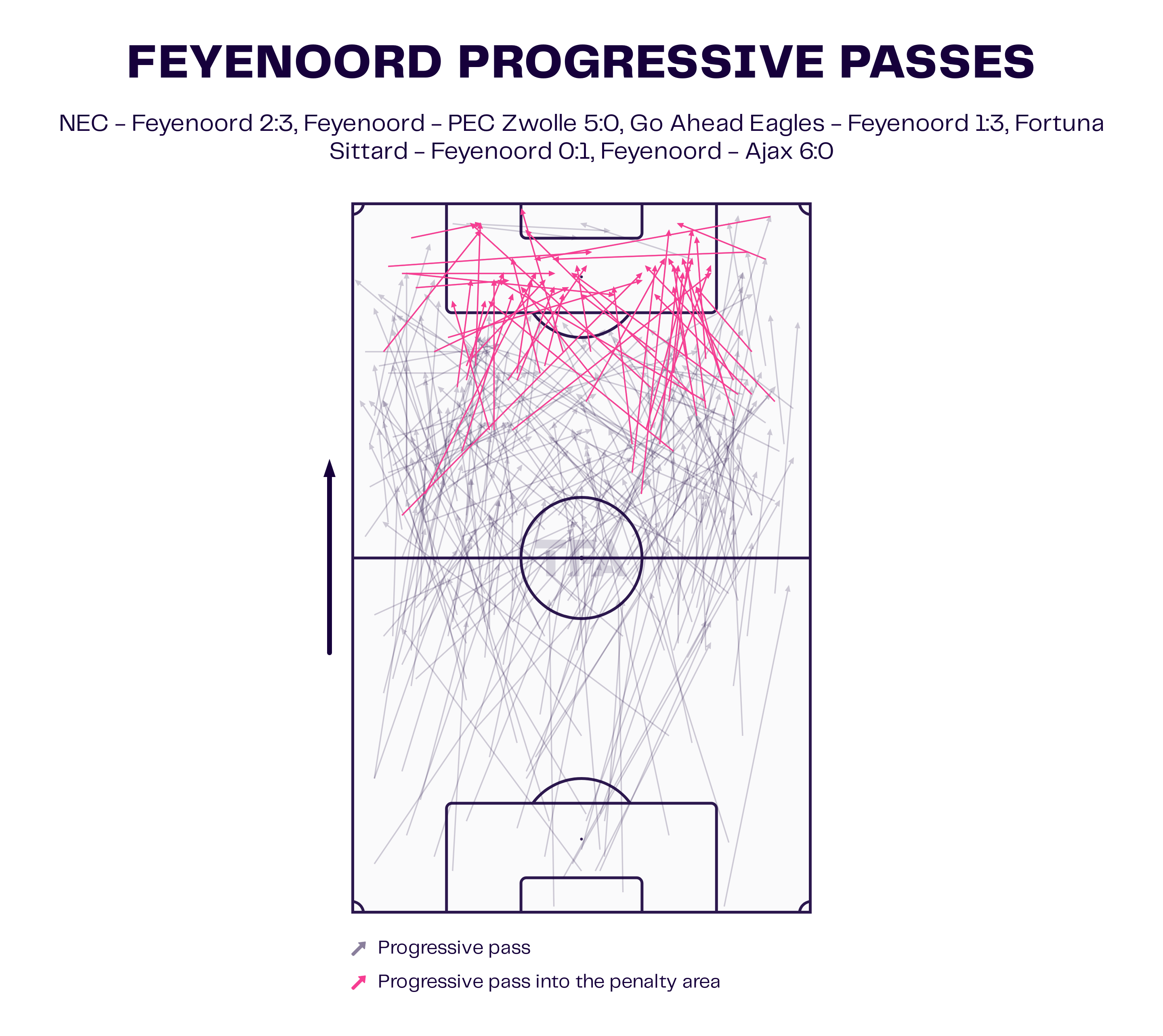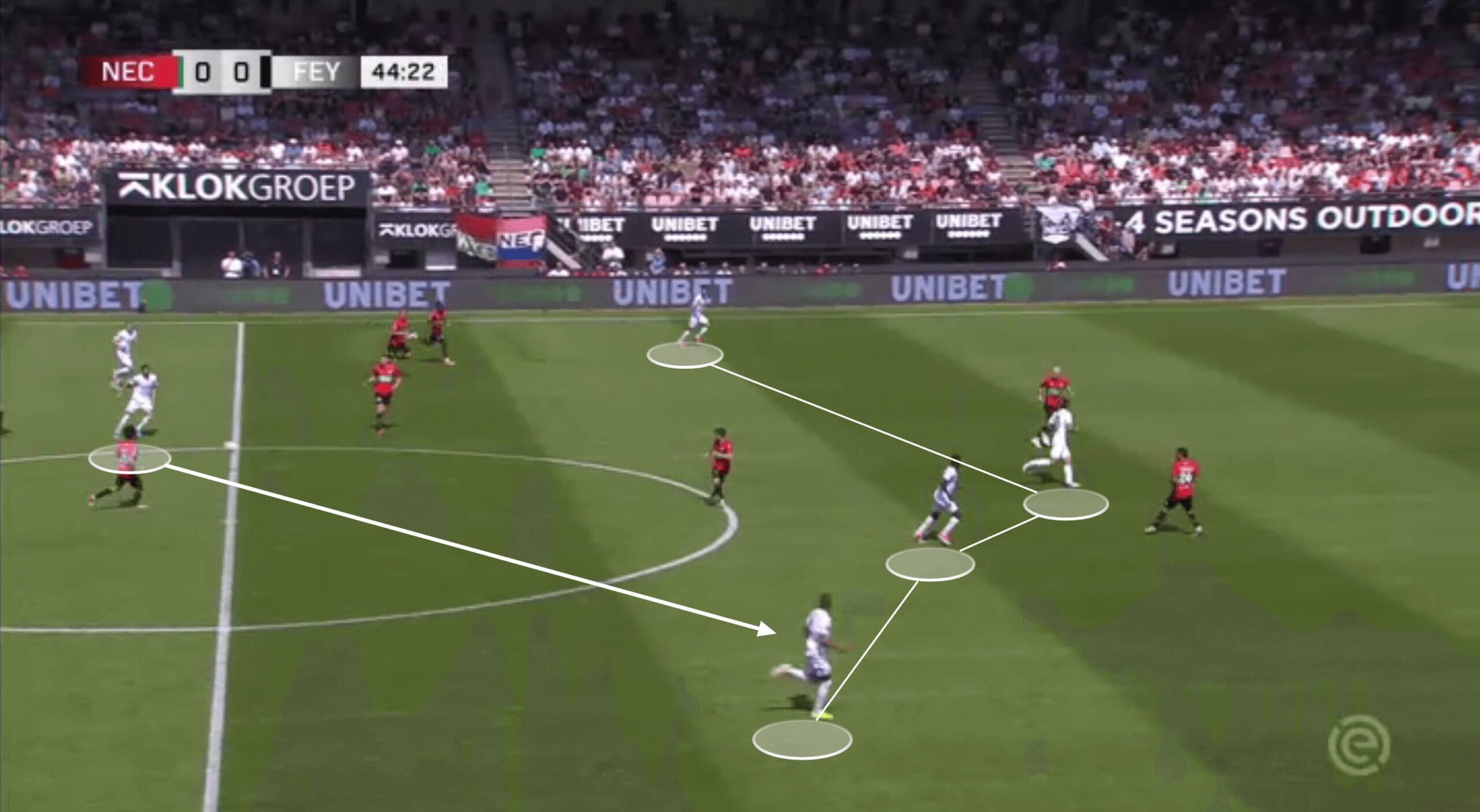
Contents
The open secret
The fact that Slot was the man that the Liverpool hierarchy had identified was an open secret in the media and amongst the fans. Liverpool have, of course, built a reputation in recent years for the extensive use of data in their player recruitment processes. (Rockborne, 2023) The club’s data science and analysis departments extended their use of data to the search for a new coach. They identified coaches from around Europe who met specific criteria set by the club. As a football data provider, we thought it would be interesting to delve deeper and see if we could find a data-driven reason for Slot to be the chosen one. In cooperation with Total Football Analysis, we’ve delved into the xG data of Feyenoord under Arne Slot.
Expected Goals (xG) and Slot’s Appeal
Without having inside knowledge of these criteria and the selection and filtering process, we can make an educated guess that expected goals (xG) played a significant role in deciding which coaches were worth taking a deeper look into. Using xG ourselves we can examine the specific attacking outputs and performances from some Feyenoord matches over the last few weeks of the season with a view to both explaining why Slot was so attractive and what Liverpool fans can expect to see under their new Dutch coach.
Examining Feyenoord’s xG Data
In the first instance, we need to examine the xG data from our Football API for Feyenoord in the matches that we have selected.
| Date | Opponent | xG |
| 07/04/24 | Ajax | 3.36 |
| 14/04/24 | Fortuna Sittard | 1.99 |
| 25/04/24 | Go Ahead Eagles | 1.32 |
| 05/05/24 | PEC Zwolle | 4.82 |
| 12/05/24 | NEC | 3.67 |
In each of these matches, Feyenoord came out as the winners, but at times, they underperformed their xG notably. In the match against Fortuna Sittard, for example, they finished 1-0 winners when we would have expected a bigger margin of victory. In other matches, they overperformed their xG as was the case against Go Ahead Eagles where they generated 1.32xG but won the match 3-1.
Breaking Down xG: Set Plays vs Open Play
The key thing to remember is that their xG was generally consistently positive in the Eredivisie. However, this was combined with an attacking style of play that was possession-dominant, which enabled them to dominate matches and play, for the most part, in the opposition’s final third.
We can drill further down into the xG data in order to build a more complete picture of the way that Feyenoord dominated games and created chances against the opposition by breaking the overall xG figure down into expected goals from set plays (xGSP) and expected goals from open play (xGOP).
| Date | Opponent | xGSP | xGOP |
|---|---|---|---|
| 07/04/24 | Ajax | 1.17 | 2.18 |
| 14/04/24 | Fortuna Sittard | 0.75 | 1.23 |
| 25/04/24 | Go Ahead Eagles | 0.10 | 1.21 |
| 05/05/24 | PEC Zwolle | 2.40 | 2.42 |
| 12/05/24 | NEC | 0.61 | 3.06 |
As you can see, other than the match against PEC Zwolle, which ended 5-0 to Feyenoord, there was a clear difference in terms of xGSP and xGOP with the majority of the threat and chances created through open play. As a possession-dominant team who typically play high and occupy the final third of the pitch effectively as Feyenoord did under Slot, they progress the ball and create chances through their ability to break lines and break into the opposition area either centrally or through the half-spaces.
Let’s examine this in more detail by isolating the penetrating carries from Feyenoord from the matches we have selected from our data set.

Penetrating Carries and Progressive Passes
Penetrative Carries
It is interesting to note that Feyenoord will penetrate through a carry, or dribble, from positions in the half-spaces or from positions more central and outside the opposition penalty area. Because they are so possession-dominant, they end up with players and numbers in spaces across the width of the final third and even in the opposition penalty area. This means that they are able to create overloads and opportunities to penetrate by driving in possession and breaking into the area.
The ability to play in the final third and create opportunities to break into the opposition area will, of course, create threat and chances in advanced areas. And these chances, in the opposition penalty area, will lead to chances that have a higher xG value.

Progressive Passes
We can also look at the progressive passes, and particularly the progressive passes that penetrate into the opposition area. Analysing the last five matches from Feyenoord, we have chosen to examine, we again see that a lot of the threat comes from the half-spaces, on either side of the pitch, or from the central spaces in front of the opposition area. Feyenoord only tend to really create threat in the wide spaces when they create opportunities to isolate and outplay the opposition 1v1, but they get these chances through their occupation of space centrally and through the fact that they can penetrate from these central spaces either through carries or passes.
This central occupation will naturally force the opposition to defend in narrow positions and this will create opportunities when they do get around the area and then play the ball out and into the wide spaces.

In-Game Examples
Next, we can drill down even further to examine some in-game examples of the kind of positions that Feyenoord got themselves into in these matches and why these positions then result in them being able to generate higher xG opportunities.
Example 1: Transitioning to Attack
Let’s start by looking at how Feyenoord transitioned into the attacking phase of the game. The right example shows them moving into the attacking phase from the match against NEC. As you can see from the image, they are extremely quick when it comes to pushing players forward into attacking areas and will overload the opposition in central areas.
By quickly moving players into advanced positions, as we can see in this example, they are putting immediate pressure on the opposition to slow them down or prevent them from creating opportunities to score.

Example 2: Established Attack
Let’s discuss another example from the match vs. NEC for Feyenoord. This time, they are in a more established attacking phase, with NEC in a more compact defensive shape. Immediately, we can see how Feyenoord is positioned across the final third, with players either in the half-spaces or the central areas. These are the positions that we saw in the maps for penetrative carries and progressive passes that they will exploit.
However, this does not mean that they will not be effective with their occupation of space in the opposite penalty area. Here, they also have three players who are positioned in the area ready to receive in dangerous positions.

Example 3: Exploiting Defensive Blocks
These are the positions where they will exploit opportunities to outplay the opposition’s defensive block and defensive structure. With the opposition defending narrow, we can see that Feyenoord has a player positioned wide to receive the ball, as we discussed earlier.
The progressive pass breaks the line and puts the wide player behind the opposition defensive line and into space. We have highlighted Ayase Ueda, who was the eventual goalscorer. In this example, the wide player cuts the ball back centrally so that Ueda can finish centrally and inside the opposition six-yard box. A very high xG opportunity is created.

Example 4: Quick and Incisive Play
One of the most effective things we saw from Feyenoord last season under Slot, and a big reason for their ability to generate so many expected goals, was that they were willing to be quick and incisive when they had opportunities to play the ball forward and into dangerous positions.
We see an example of this here for the opening goal vs. Ajax, as the Brazilian wide forward Igor Paixao is positioned on the last line, waiting to make a decisive run behind to break the last line and create a shooting opportunity. While we have described Feyenoord as being possession-dominant, and they were, they were also willing to be direct and aggressive when the opportunity arose.
What Liverpool Fans Can Expect
Liverpool fans should be excited, as they are getting a coach with a clear and defined game plan that will generate high xG opportunities. They are also getting a new coach who has the versatility to play more aggressive, forward-thinking football when the need arises.
